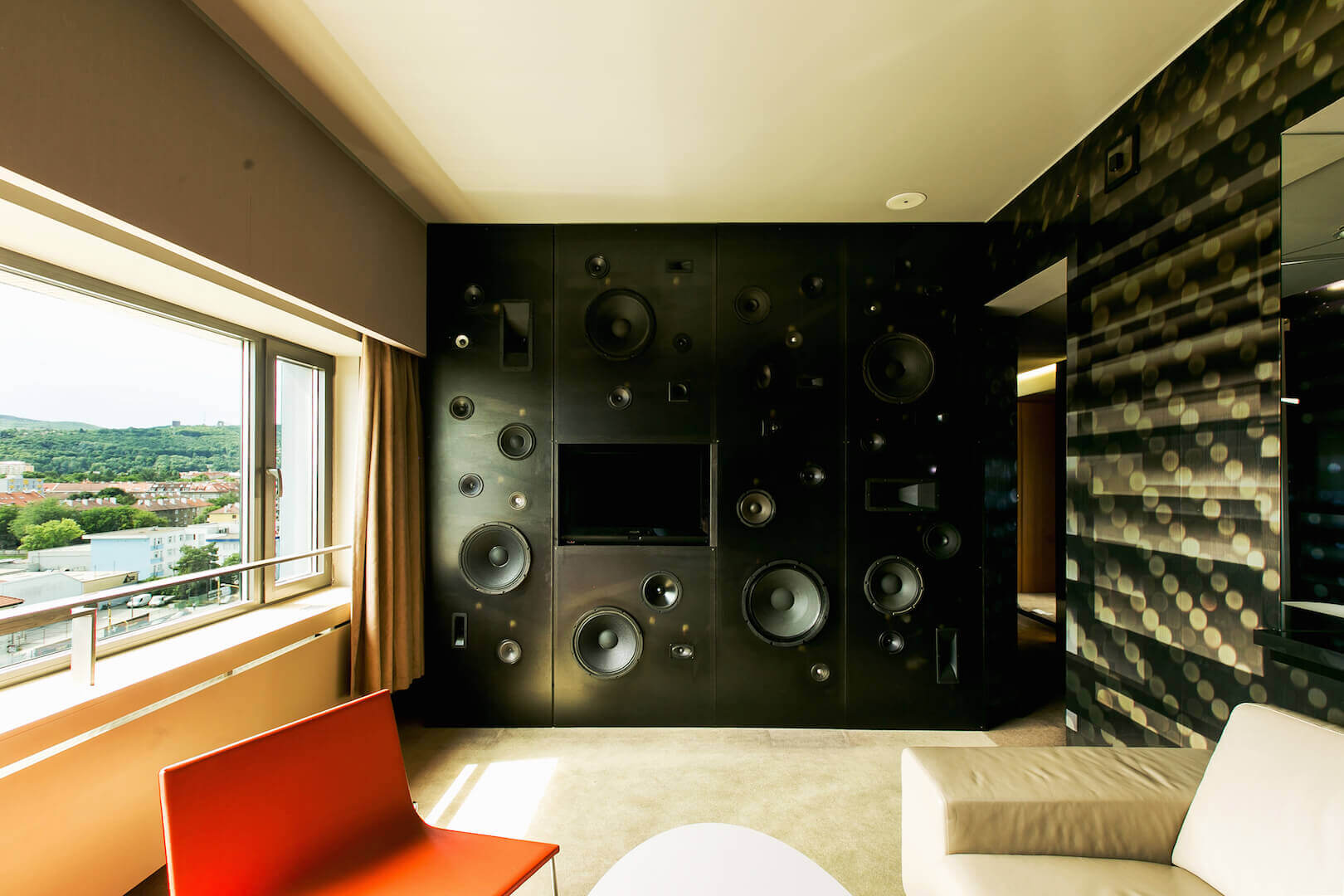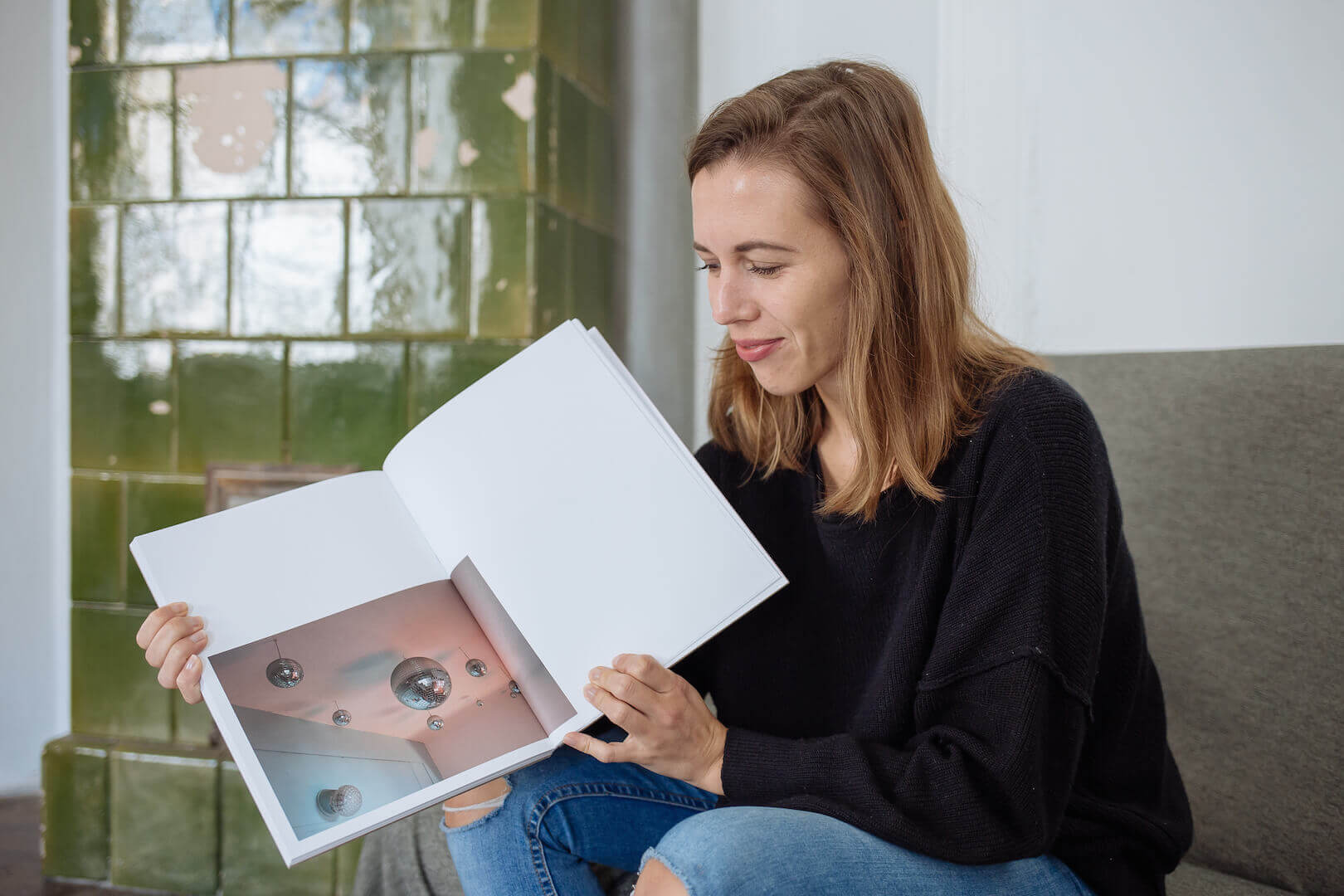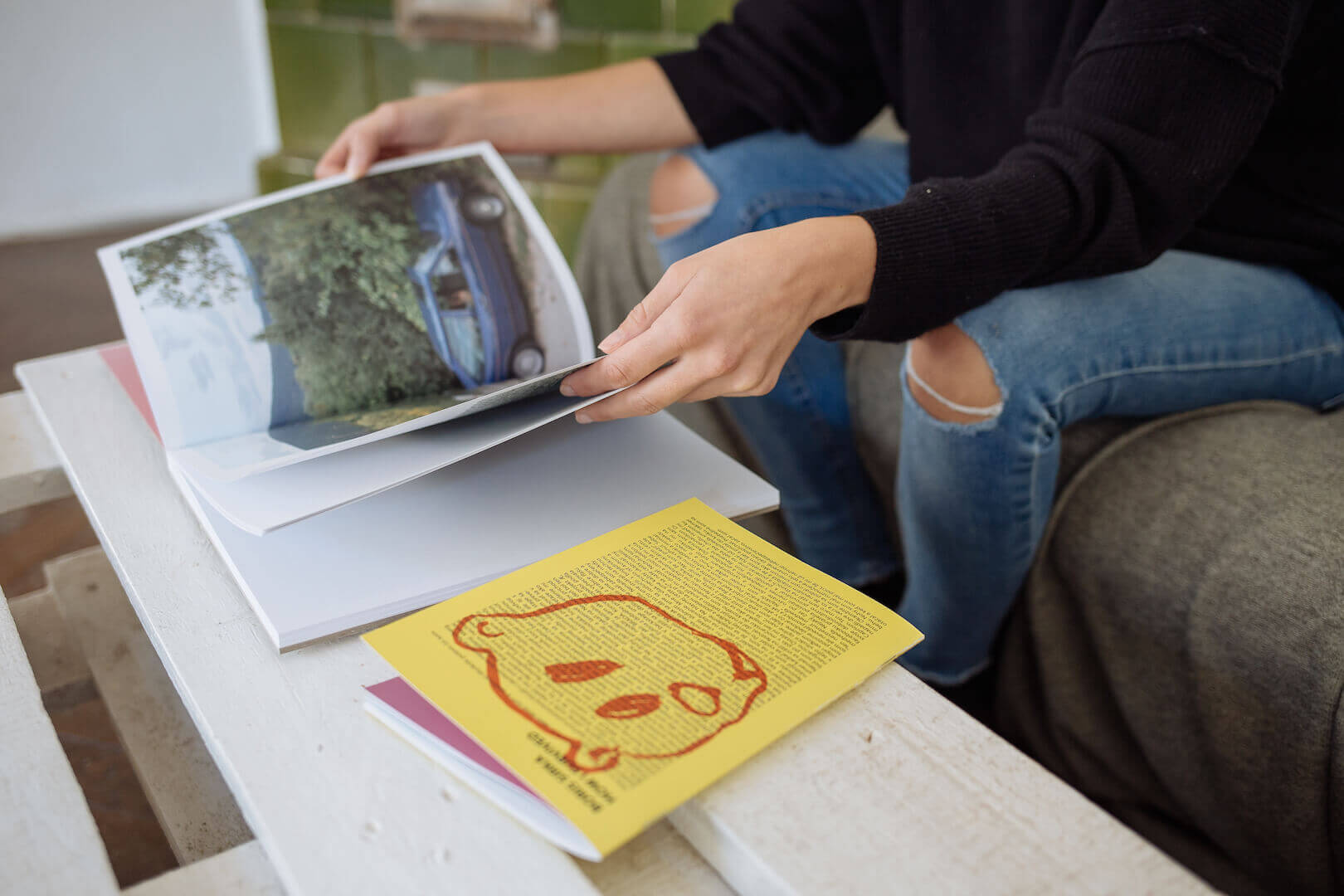Experience the gallery with a remarkable international program: Šopa
Petra Housková and Zuzana Tóthová run Šopa Gallery — a contemporary art gallery, as well as the K.A.I.R. (Košice Artist in Residence) programme, which invites foreign artists to Košice and sends their Slovak colleagues to residencies abroad. Read more about connecting the global art scene to the local one, what a residency in Košice has to offer to artists from all over the world and about everyday trials and triumphs that come with managing an independent art gallery.
What inspired you to start an independent art gallery?
P: The idea itself dates back to my studies at the Košice Faculty of Art. Back then, I used to work with Viktor Fefér and others on the Street Art Communication project. We were looking for a place for our activities and that’s how the Pyecka Gallery started in 2012. Finally, we had an exhibition space and one day Viktor told me: „OK Peťa, it’s time for you to start an association.“ And so that’s what I did (laughs). The beginning was very spontaneous and, at times, a bit awkward. The project was still taking shape. Our selection of artists and the exhibition concept evolved gradually, though, and the major change came in 2015. The Street Art Communication association decided to move to the newly opened Tabačka and I chose to stay and continue my gallery project in Vitézov dvor. That’s how a new label was born. The Šopa Gallery is currently the only active independent gallery in Košice and manages to contribute significantly to the activities of the city’s established cultural institutions.
Why is it the only gallery of its kind in Košice?
P: My own experience has taught me that keeping such an exhibition space is not easy. In fact, it’s a very unstable thing and can never be seen as a source of income. At the end of a year, we never know if we’ll be able to stay open. I remember the first year as a very tough one. The funding we managed to get barely covered the rent. There was nothing left for exhibition dramaturgy. I spent my own money on the project, hoping that one day it’ll get better. That was a huge gamble but fortunately, it paid off and we got the good news about having been given a grant literally at the last minute.
Was that the moment when Šopa Gallery joined forces with the K.A.I.R. (Košice Artist in Residence) project?
P: Somehow our paths crossed naturally in 201 when Zuzka and I started working on both projects together.
Z: It all started when we decided to move our residency programme out of Kulturpark and were looking for a new venue. At the same time, the Street Art Communication guys were leaving this place for Tabačka and there was a free space right next to the Pyecka Gallery. In addition to that, I was at that time looking for someone to help me with K.A.I.R. and Peťa needed help with her gallery. And that’s how we started working together.
So what is it like, having an art gallery and a residency centre working side by side?
Z: Our first shared project was an exhibition of Boris Sirka’s work. That’s when K.A.I.R. and Šopa first joined forces because it was the first exhibition at the Šopa Gallery and it featured the pieces the artist created in Tokio. We organise exhibitions for some of the foreign artists who come here, but certainly not all of them. Keeping the urban character of the residency programme is crucial for us.
P: It depends on the project and we always try to find an adequate space that would meet each artist’s individual needs.
Would you say that your focus has shifted more towards foreign artists?
P: I don’t think so. Our exhibition programme is quite balanced. Every year we also give a chance to one young artist to present their work. We publish a call open to recent art school graduates interested in presenting their project to the public.
P: Also, not all the visiting artists come to Košice through the residency programme. Some are selected based on the gallery board’s decision.
Z: Some artists are selected for K.A.I.R. because their work fits the Šopa Gallery concept well, while for others we have a completely different space in mind. And there are some artists whose work we want to exhibit without offering them a residency.
P: Just like Beata Rojek and her current exhibition.
Is there anything specific that your visiting artists have been taking with them from Košice?
P: As far as residencies are concerned, the process is more important than the result, which is often still a work in progress. The artist gets to know a new place, meet new people … Our aim is to connect them to local artists and people active on Košice’s cultural scene so that they can cooperate. Usually it works very well and it’s beneficial for the resident as well as local artists. The cooperation often continues well beyond the period of the residency and that’s what makes us really happy.
Z: Some projects are long-term ones. Right now, for example, the Ziggurat Project dance group is preparing a dance installation. They came last year and we asked them to come again and continue the project they’d started. Sometimes foreign artists meet in Košice, start working together and decide to meet here again. It’s all about cooperation.
P: I’ve seen people fall in love with this city and decide to stay, such as Kaoru Furuko, who came for two months and ended up living in Košice for two years. Others, on the other hand, fall in love and take someone away with them. That’s been a side effect of K.A.I.R. as well (laughs).
Peťa, in addition to managing the Šopa Gallery, you’ve been working for the Eastern Slovak Gallery. Have you seen many contrasts moving between the worlds of independent and institutional art?
P: Getting to know the workings of such an institution has been a very interesting experience for me. In addition to the contrasts, many issues are the same, just on a different scale. The major drawback of an independent gallery is that it cannot afford a full-time employee and so, in order to survive, we all need a second job. I’ve been lucky to find one that complements my independent gallery work. And I’ve learned so much in less than a year that I’ve been working there as a PR manager. We used to have PR issues in Šopa and now I can apply all that I’ve learned here.

Both of you studied abroad and decided to return to Košice. Why?
P: When I think about it, I’d say it was the feeling of responsibility, which is what still motivates me. I believe that our work makes a difference for the culture in Košice. If there were no residency programme or the Šopa Gallery, I’d probably consider leaving but only to come back again and start something new (laughs).
Z: I didn‘t want to come back. Studying in Prague, I had a great experience there and only decided to return for personal reasons. In retrospect, that was probably one of the best things I could’ve done, even though back then, I had no idea what I’d be doing here. In the end, I managed to find my place on the local cultural scene very quickly.
Do you see much difference in how independent culture works here and abroad?
Z: I don’t think so. The conferences we attend show that similar programmes or galleries as our usually deal with the same issues.
How about the artists who come to Košice from all over the world, for a residency or an exhibition? Do they feel like they’re coming to Eastern Europe?
Z: Before they come, they probably don’t know much about what to expect, Košice hasn’t been so widely promoted yet. But once they’re here, they realise it’s not the end of the world. Košice has a specific atmosphere, especially in spring and summer, which is when most artists start their residency. Those who come in autumn or winter are probably less excited because the spirit of the city is different in summer. We’ve decided not to do any residencies in January and February (laughs).
Zuzka, you’ve also been taking part in a network that connects European artists to their colleagues from the Middle East. What can you tell us about this experience?
Z: With CIKE, we’ve been given an opportunity to participate in a major European Project called Borderline Offensive. It’s a very ambitious project that addresses the issues of migration and refugees through the medium of humour and other politically incorrect means of communication, all reflected in art. Last week we attended a meeting of 13 European and Middle Eastern partners. It was very interesting to see what our local artists, whom we invited along, had to say about this topic, such as Janka and Peťo from the ‘Na Peróne’ theatre. It was very powerful to hear artists from the Middle East talk about refugees, borders and the war … One can still find humorous aspects in all that but at some point, there’s just nothing left to laugh at. I’m still processing that experience but I’m also looking forward to the project, because I can see its importance, especially for our country. This year, only 17 asylum seekers have been granted the refugee status in Slovakia which, compared to some of our partners, such as the Netherlands or Sweden, is laughable. That’s why our take on this topic will be a more individual one.
Does your gallery address political themes as well?
Z: We’ll definitely be hosting this project’s activities, including events for local artists and for the public, open studios … It depends on the project.
P: Those themes are among the ones relevant to our society today. Last year, we had an exhibition of Oto Hudec’s work that addressed migration as the result of climate change.
Z: We have an ecology-inspired residency coming up and we’re definitely trying to reflect important global issues. For instance, our current resident artist, Olga, explores online propaganda.
Let’s leave the global scene for now. What are your thoughts on the current young art scene in Košice?
P: Naturally, we’re interested in what’s going on and regularly go to see students’ works and exhibitions at the Faculty of Art. Unfortunately, most of the students don’t show up at exhibition openings, exhibitions and other events. Not only at Šopa but the Eastern Slovak Gallery and other institutions as well. It seems to me that we used to be much more invested in the culture of this city as students, we attended exhibition openings and discussed art. But I believe it can change for the better.
Z: We’d definitely expect more students to take part, especially in workshops. There is a small group, though, that comes to all the exhibitions openings and concerts.
Are the Faculty of Art students apathetic?
P: I had that feeling even when I was a student there myself but it’s hard to say. It might actually be getting better now.
Z: New people, for instance, the PhD students, have certainly brought some positive change. The last student exhibition we saw in winter was much better, especially the paintings.
P: It’s hard to generalise, everything depends on the individual and their effort, on how seriously they take their studies. Take Alex Selmeci, Tomáš Kocka, Oskar Felber and Ingrid Kepková, for instance. They work hard and it shows.
Speaking about the school — Peťa, you majored in painting. How about your own art?
P: Well, what do you think? (laughs) Working 12 hours a day at an art gallery, running an independent project and a residency programme doesn’t leave you with much time for your own art. Still, I think that what I do is very inspiring and creative and I haven’t given up on creating my own art either. It’s just the way it is right now and I know that, in the future I’ll have to give one of the projects up. From time to time I get very frustrated and want to do art full time. Last year, I spent two months at a residency in the Czech Republic (the ‘Na shledanou’ gallery) and that’s when I became very aware of this need. I really enjoyed the process, being able to fully focus on my art. I was hoping that I’d be able to continue at home but guess what? (laughs) I do get some time to do my own thing occasionally, but it’s not nearly enough.
Do you get any feedback on your projects?
P: I believe the feedback we get is mostly positive, although it depends on the project and artist. I’m a bit disappointed that people seem less interested in the exhibitions of foreign artists, who aren’t yet known to the public in Košice. Only about a half of our regular audience comes to see them and I’m still not sure why.
Z: There are times when I think that people prefer to talk about how well we do things instead of actually coming and supporting us, even though Košice is a vibrant city when it comes to art. But we already have our regular audience, even though all that we do is non-commercial, not aimed primarily at ‘the people’, the general public. Still, they come again and again. Building and keeping an audience for this kind of project is a challenge, even more so if you don’t have a bar or a coffee shop and don’t organise parties.
Why have you decided to add concerts to your programme this year?
Z: We all know that most people attend the exhibition opening but very few come for the rest of the week. That’s why we decided to organise workshops, lectures and concerts. Concerts are often a part of an art gallery’s programme so we’ve started organising solo concerts in our gallery once a month. Our venue is ideal for that.
P: Exactly. We have the perfect space for concerts and we’re free to try more experimental things. These concerts will also attract new people that might not have heard about the Šopa Gallery before. But once they’re here for the concert, they stay to see the exhibition and usually come back again. The same goes for lectures. Last year, during Oto Hudec’s exhibition, we asked a climatologist to give a talk. Many newcomers came to hear the talk and said: “Wow, we had no idea you were here but we’ll come again”. And they did (laughs).
What are your plans for 2018?
P: There will be seven exhibitions by Slovak and foreign artists. This year there were nine. Some of them will be more demanding, which is why we’ve decided to reduce the number of side events. We’re also going to improve the quality of side events — talks, presentations, debates, docent-led tours, workshops and courses — for each exhibition. Some exhibitions will stay open for several months and we hope that the quality of our programme will attract new visitors.
The highlight, at least for me personally, will be the project organised in cooperation with the Trafó Gallery in Budapest, to be more specific, with its curator Áron Fenyvesi. It will most likely be a group exhibition featuring several contemporary Hungarian artists. I’m really looking forward to Jaro Kyša and also Anežka Hošková, who’ll be spending two months in Košice as a K.A.I.R. resident artist. In the future, we are hoping to start cooperating with other galleries in Slovakia and abroad and to be able to present the work of our artists there.
One last question — what’s the name of that piece behind you?
P: That’s one of Beata Rojek’s works of art. She’s one of the youngest generations of Polish artists and a graduate of the Wroclaw Academy of Art and Design. She focuses predominantly on painting and the piece you can see here has been created specifically for this space. It stems partially from her previous work that tried to capture perfect structure, movement and tension. However, at a certain point, these carefully assembled units began to fall apart and their fragments opened new, unlimited opportunities to explore their mutual connections. The story that this author has to tell is not yet complete, as suggested by the title of this exhibition — I still can’t see the whole.

Want to explore the unique art exhibitions of Šopa Gallery? Book The Invisible Hotel now.















